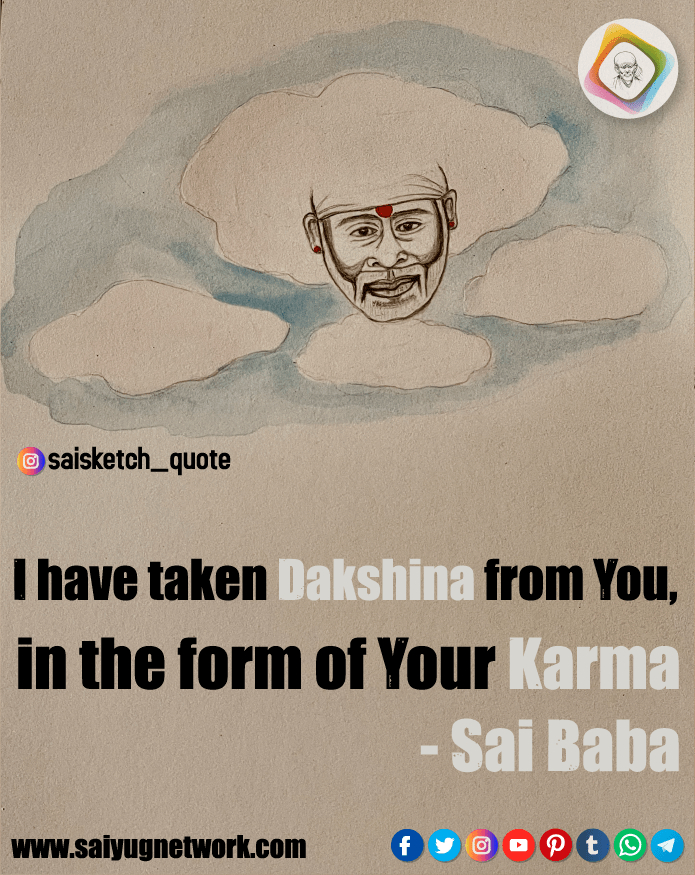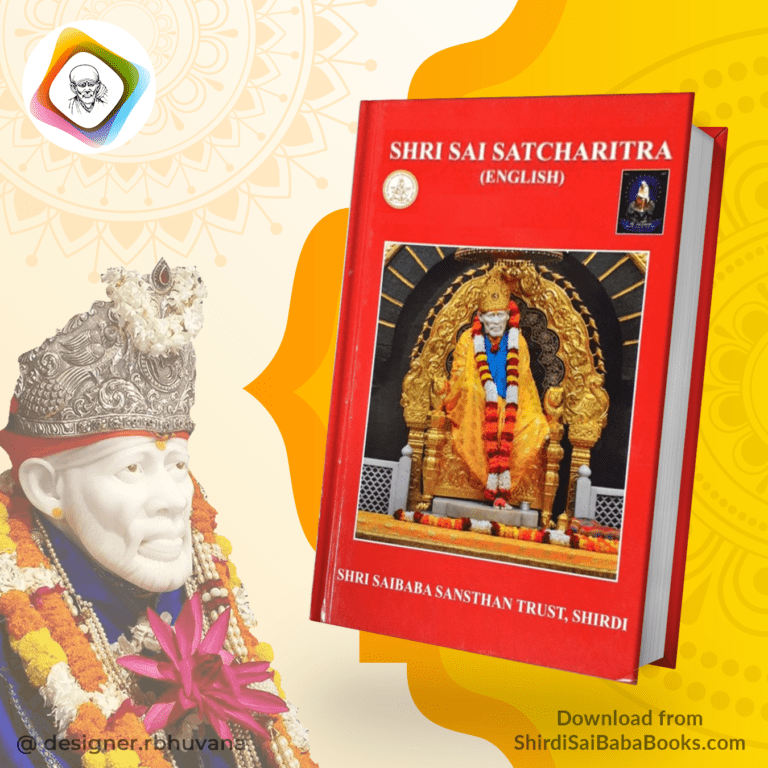
INTRODUCTION
SAI BABA OF SHIRDI
Knowledge is God. All the existing essences of life are present in Knowledge (Dayana). Knowledge is Supreme. One should be convinced and clear about this fact. Acceptance of the reality turns into experience. If you utter the words ‘Sai-Mauli’ with the visualization that Sai-Maa is near you, observing you lovingly, and that She never leaves you alone, then you will actually get the same experience. Bhava (Emotion) turns into reality. Dnyana is reality.
Because of the power of knowledge (which is God), Prana flows in our body and senses perform their functions. This shows that God is constantly present in every being as consciousness or Chaitanya. Children play a game of mock house. In the game they use pebbles and ‘cook’ different items with those pebbles e.g. Laddus. If their mother gives them a stone in place of laddu, they will not accept it and will cry. But while playing ‘mock house’, they know, It is not a laddu but simply a pebble. Therefore this laddu is unreal”. We have to remember that the world is unreal and deceptive, because the objects of thi world will not fulfill our aim, that is search for knowledge.
Body, mind, intellect and knowledge are not artificial, but absolutely natural. All these are not man-made but are made by Him. He has equipped us with many miraculous ‘fittings’. But we never bother about what in-built gifts God has given us. Liking for something or interest is one such miraculous gift. If mind develops interest in a particular thing, it tends to constantly be with it. So saint Dnyaneshwar says, “Try to develop your interest in Nama Jap and your mind will automatically be attached to God”.
Intellect is like a step-mother of ‘interest’. It always condemns the interest. Calumnious intellect will find out vices in ‘love’ also. But love is not an external thing. It is inside you. Existence of love, body, condensed mind, intellect and ego must be recognized. If we fail to do so then talking about reality will be meaningless. Death is inevitable for all beings. But when saints offer their body to the five fundamental elements, their subtle body still remains engrossed in contemplation on God. Therefore the climate around their Samadhi-Sthana or their temples is pervaded with God-Principle. Many Saints or Vibhutis have taken birth in Maharashtra, and have become famous all over our country. Some of them are, saint Dnyaneshwar, Tukaram Kabir, Sajjan Kasai, Chokha Mela… and many more. All saints do not give precept or form their denomination or school. All do not write scriptures. But some of them do some of these things or some may do nothing. In whatever category they may fall, all saints are capable of elevating the mundane life and the world. At the Samadhi place of Dnyaneshwar in “Alandi’ (a town near Pune), people get spiritual experiences even after about 750 years. In the same way Baba is giving experiences to many of His true devotees
Sai Baba’s poetic biography Sat Charitra had been written by Annasaheb Dabholkar, when Baba was alive in person and He had blessed it Himself and He gave Dabholkar the title of ‘Hemadpant’ (a genius). Many devotees wanted the biography to be written in prose. Therefore according to devotees wish and inspiration from Sainath, I (the author) have done this effort.
In Gamdevi. Mumbai, a saint Balkrishnabuva Sutar (Balabuva) was known to all. He looked like saint Tukaram. His attitude also was ascetic like him. Using two flat, slim stones as cymbals, he used to sing ‘Bhajans’ and ‘Abhangs’ (spiritual songs). People used to call him ‘Modern Tukaram’ When he went to Shirdi for the first time, for Baba’s darshan, Baba saw him and said, “I know you for the last four years”. Balabuva thought, “This is my first visit to Shirdi; and Baba has never left Shirdi. Then how does He say that He knows me?” When he stretched his memory, he remembered that he had seen Baba’s photo four years ago and joined his palms in prostration. Baba had picked that reference. Buva was amazed learn about Baba’s omnipresence and love for devotees. The author thinks that looking at the photo of Sai and His actual darshan is one and the same thing. Here is his simple explanation.
Working of a human eye is similar to that of a photographic camera. There are lenses in both the objects. When the rays of light pass through the lens the image is formed on the retina, in case of human eye. It is further conveyed to the brain and the Jiva senses, understands about the image. Suppose, Baba is actually in front of us, His image will be formed on our retina and we will see and sense His existence. For grasping it we must be attentive and have full concentration. If we lack in attention and concentration, and our mind is focused on something else, then we will fail to take the cognizance of what we would see. Then it will not make any difference whether Baba is before us or not. It means, when we look at Him with our mind, with our sentiments, with love and Bhava, then only we get the specific effect. So, what is important is the intensity of sentiments, depth of love and focus of emotions. When the intensity goes on strengthening then the image of Baba on our mind screen becomes more and more bold. Even if Baba is physically not present in this world, we can see his photo or image and experience the same bliss of His darshan through meditation.
God is the embodiment of love. Saints are not different from God. They too are love personified. Love is present spontaneously in all beings. Entire life force inclines where love directs. Rather, inclination itself love. This love has to be brought to awareness; and it done by the precepts of saints. Dicta of saints awaken the Love for Self. Then it becomes through Namasmaran (Chanting the name and remembering God) Devotion is not an act. It is to be sensed. It is to become aware; aware of the fact that He is the Doer. Everything that has to happen will happen at His will. Jiva is there only to comprehend. Jiva must realize that God principle manifesting through him. The basic love is vehicle of all the actions. This awareness itself is the fusion with Sai. With this awareness Jiva can experience sweetness and pleasure of love. A child believes that he totally belongs to his father and so he can enjoy affection and affluence of his father. He does not have to put in any efforts for that. In the same way, when one united with God Sai he enjoys intrinsic pleasure of devotion.
That Dharma, which creates and motivates desireless, steady
non-flickering devotion towards the Lord, the ‘Parama-Dharma’ (supreme religion). The Lord called “Adhokshaja”. Let split the word ‘Akshaja’ (Sanskrit) means the knowledge received through orgaans (Indriyas). But this pseudo-knowledge cannot limit cover overshadow the Purity of Lord Supreme. So He called Adhokshaja, who beyond ‘Indriyas’ i.e. organs. To conquer the Supreme with the instrument of unflinching devotion the supreme duty or Dharma of human being. The devotion leads to asceticism. If actions, however righteous, cannot spur love and devotion for Omnipresent Lord, the mind of person, then those actions are merely part of drill fruitless exercise. So one must hear and sing the glory of Lord Vasudev Krishna, contemplate Him and worship Him. With these tools, devotion evoked the mind. All the actions are Veda-chanting, Yoga, Yajdnya, Dnyana, Penance, and righteous actions aimed to realize the Lord Krishna. When one successful establishing the Lord in his heart, he becomes ‘free’ from the ties Karmas. To evoke such devotion one must be the company of true devotees.
Kapil Muni says, “He who constantly listens the stories God, gets higher type of pleasure. His ears and heart enjoy bliss. He comes to the power and potency of God. He then finds the way liberation’. progressively enjoys the pleasure of faith, love and devotion towart God.” (Ref. biography of Kapil Muni, Skandh chapter 21-23) By singing the glory of the God, many sinners had attained liberation. Seeds of ‘Vasanas’ (desires) get burnt only NamaSanKirtana (Chanting the and singing His glory). One must start loving God. There is way to loving Sai Baba and author believes that the only way is biography of Baba titled “Sai Sat Charitra”, written Annasaheb alias Hemadpant Dabholkar Reading this sacred book and pondering over what is read and offering Aarti written by Madhav Andkar, will light the flame of love for Sai, in the heart of any person.
Though the above mentioned sacred Charitra biography was published in the year 1930, the writing work had commenced in the presence of Baba Baba took ‘Samadhi’ in 1918, but Dabholkar had taken His permission much before that. He also had read out the chapters to Baba, Who had approved the contents encouraging him to write further. Foreword of the ‘Sai Sat Charitra’ is written by another Sai devotee, Balkrishna Vishwanath Deo,
MORE ABOUT “SAI SAT CHARITRA”
Solicitor Hari Sitaram Dixit, close and dear devotee of Baba says, “My friend Govind Raghunath Dabholkar (Annasaheb), has written this biography which invokes devotion for Sai. He has preferred poetic form for it. The verses are in ‘Ovi’ metre, which is most suitable for spiritual poetry. Writing of this book was started with the permission of Baba and He had already blessed the writings. Till the date 35 chapters are completed by the author. The epic is full of love, very interesting and heart touching. Not only the Sai devotees but others will also get proper guidance through it. The Ovi form reminds the poetry of saint Eknath. In short, this Biography is a ‘Prasadam’ of Sai-Maharaj.”
Balkrishna Vishwanath Deo (Baba used to call him ‘Bal’) says, “The Leelas that are described in “Sai Sat Charitra”, have been witnessed (most of them) by Annasaheb Dabholkar, the writer of the biography. Some devotees narrated their experiences in person and some informed through letters. Many of the devotees are still alive (written in 1930). So anyone can cross check for authenticity. Annasaheb has woven those experiences in his attractive poetic language. Now 51 chapter has been published in “SaiLeela”. Only one chapter is yet to be published. In “Sri Sai Leela”, third issue of sixth year, Annasaheb Dabholkar had published the 52 chapter. At the end he had mentioned that the biography was completed with that chapter (page number 880). Preface and retrospection, in poetic form, were given to me (Deo) for checking but it was not found in the biography. So I think that part was misplaced and therefore not included. Presently, a new chapter, fifty-third, has been included in the biography,” Deo.
From: “Sai Sat Charitra”, Foreword, 20-11-1930.
“Sri Sai Leela” magazine was started in 1923. The first issue was published in the month of Chaitra, first month of Indian calendar. The Editor, Laxman Ganesh Mahajani, and publisher Babasaheb Aatmaram Tarkhad published it at 5, Turner Road, Bandra, Mumbai. The first chapter of “Sai Sat Charitra” was printed in the first issue of “SaiLeela”. This clarifies that the Biography was written before 1923. This fact is purposely mentioned here, so that the devotees should not be misguided.
END OF INTRODUCTION
© Author – Dr. Keshav Bhagwant Gavankar (Annasahib Gavankar) – Explicit Rights To Publish To Shirdi Sai Baba Books.com (Member of SaiYugNetwork.com)



